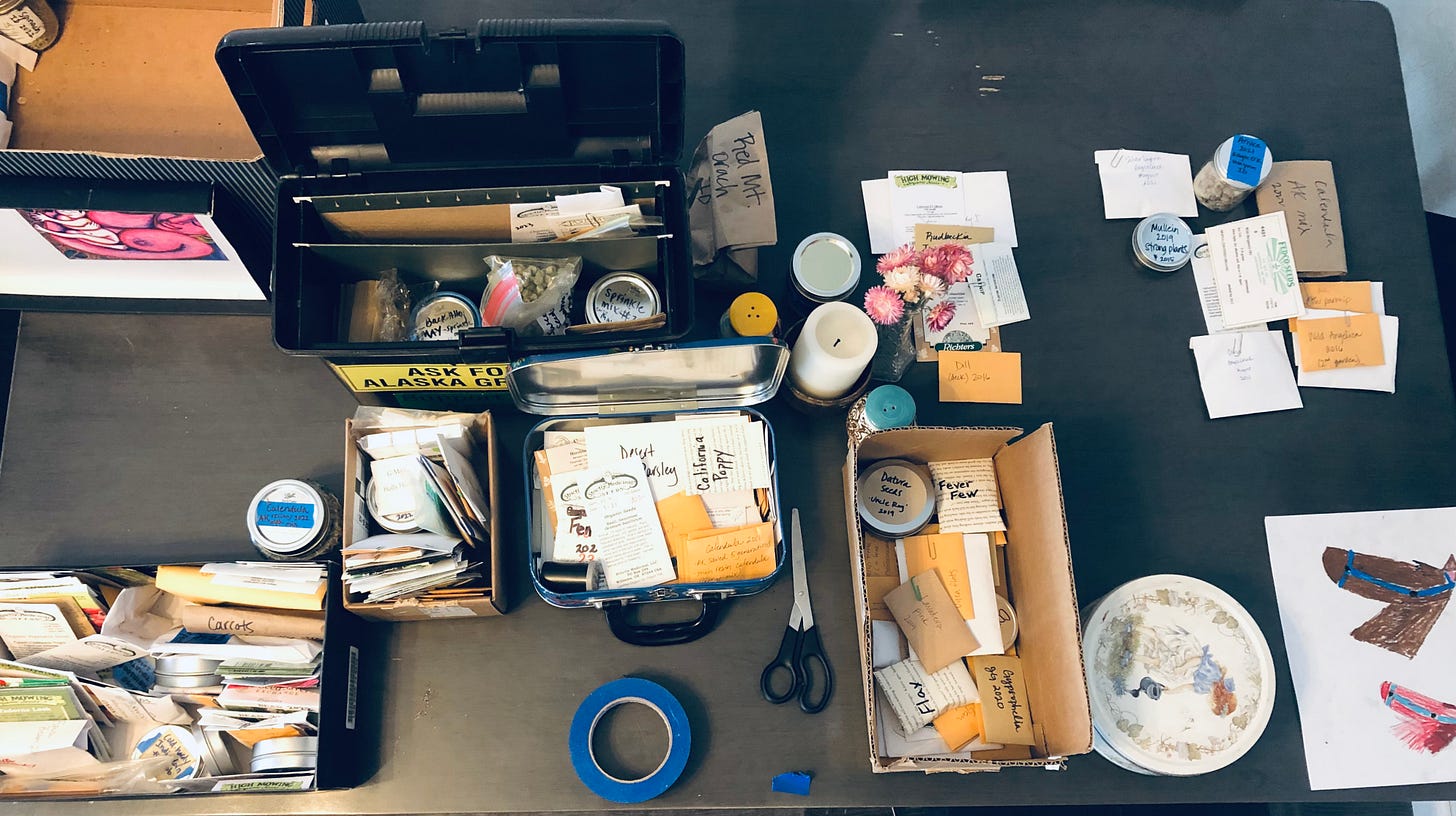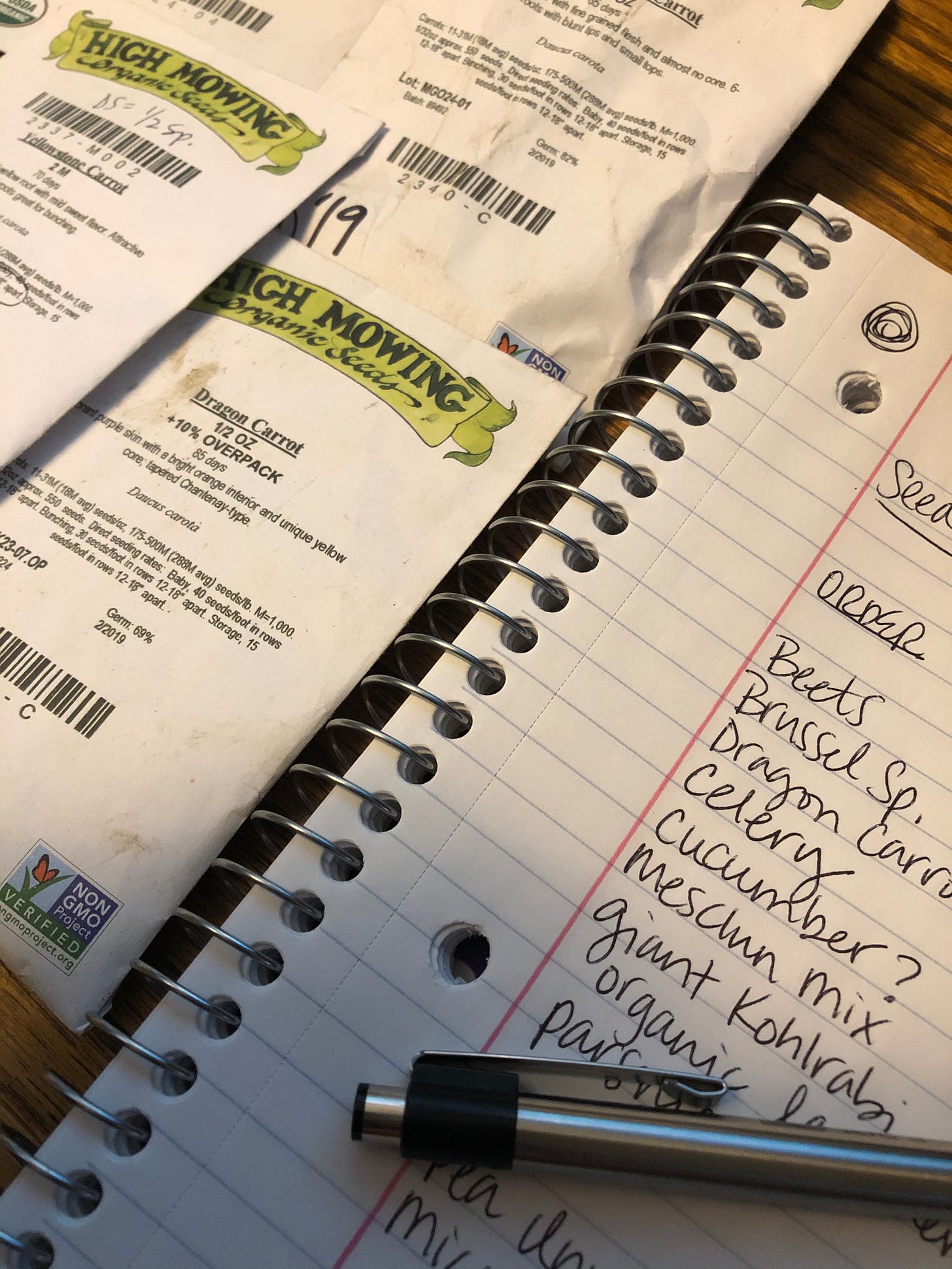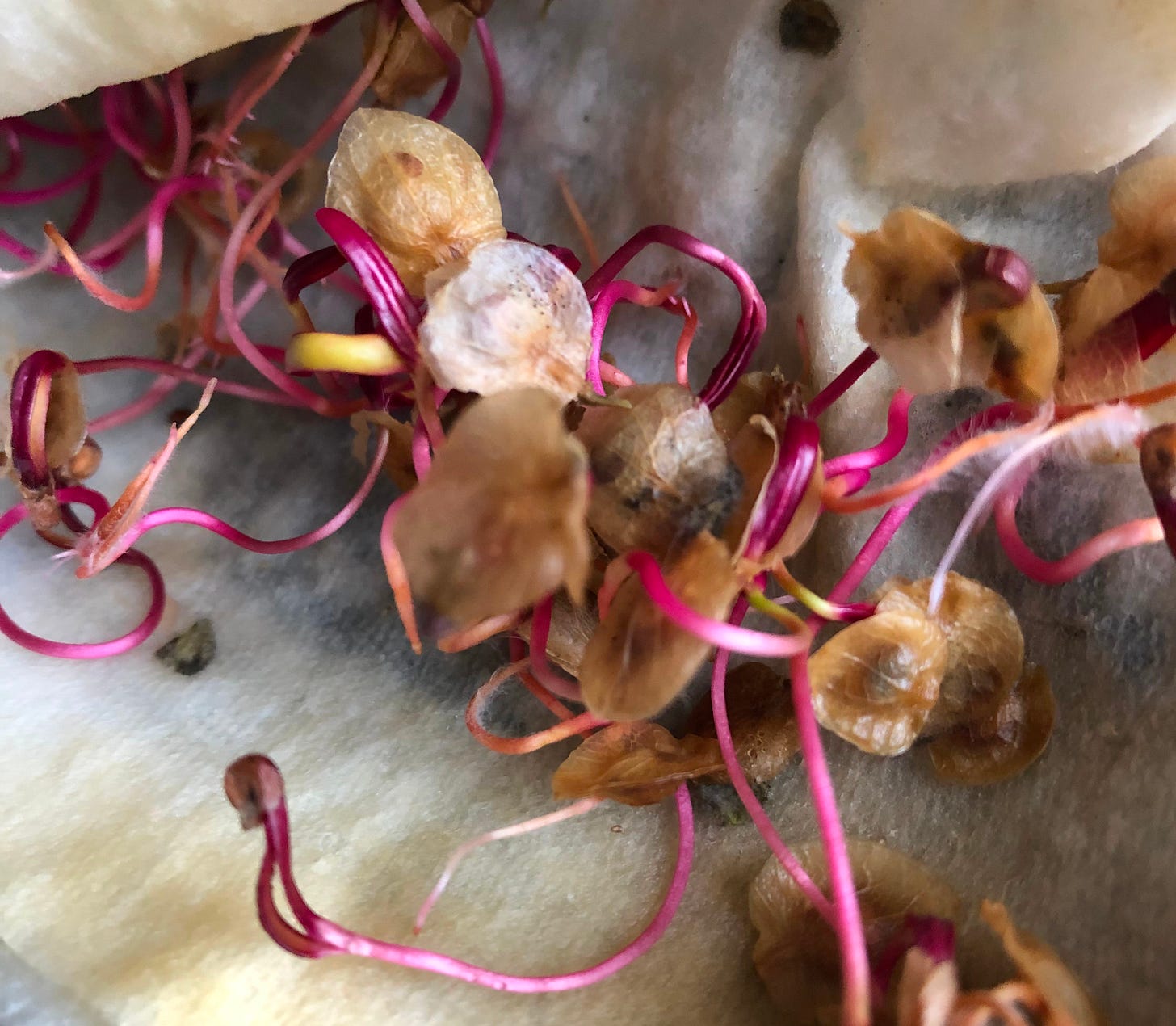Going through seed packets is a time-honored Winter tradition. I am doing this today actually, getting an idea of what I have remaining from the previous growing seasons, what seeds are getting a wee past their best by date, and to dream of the Gardens ahead. As someone with A Lot of Seeds, I tend to classify them as such: Veggie, Herb (Culinary/Medicinal) and Flower. Of course, there’s overlap between these, but that’s my general classification.
With the Veggies I order alphabetically within a sturdy shoebox. The others are more loosely strewn in their containers. The whole of them are in a medium sized box that I can store in a cool, dark place during the off-season. When I really start the seeding process, I’ll take a smaller box or basket, and place the seeds that I plan to sow within the next few weeks in there.
I’ve also seen folks use a plastic sleeved photo album to store their seeds. This is handy for those purchased packets, as they are similarly sized. You can organize whatever way you choose, but I would recommend some sort of classification system so you know how many seeds of what you own, alphabetically by common name works for many.
The photo album method doesn’t work so well for me as I have many saved seeds that are in regular-sized envelopes or small canning jars. But you could make notes for those kinds of seeds and place in there. Just an idea.
When I worked for Jewell Gardens, I came up with the Master List. An excel spreadsheet of ALL the SEEDS, plus purchased Starts and Transplanting info. It was super helpful to have for seed inventory and looking back at transplanted amounts and date seeded as well as planning for the next season.
In 2023 I made a Master List for my personal seed stash. What was fun to see was that 44% of my seeds were Saved Seed! But I still didn’t utilize the List quite as much as I did when it was for ‘work’.
But that said, I do like the organization and ability to take more notes and have everything handy at a glance. So, if you also like organized spreadsheets, here are the column headings I use:
TYPE – VARIETY – COMPANY – YEAR – A/P – QUANTITY – H/V/F – DATE SEEDED – QNTY. SEEDED – DATE TP’d – AMOUNT TP’d – NOTES – LATIN NAME
Type = (for example) Cabbage ~ Variety = Copenhagen
Year = year of seed when purchased
Company = where did it originate from
a/p = annual or perennial
h/v/f = herb, veg, flower
TP = transplant (also called Starts)
Notes = no germ, stunted plants, great germ or happy plants, grow again! or whatever else you’d like to mention
I’ll print off a copy of the spreadsheet and have nearby when seeding/transplanting and enter in data by hand (then later enter data into Master List).
Here’s an example of a completed entry, makes it easier to view if under the column headings for sure in the actual spreadsheet:
Goat’s Beard – (native, Alaska) – EGW (saved seed by me) – 2020 – P – few – F – 3/2/23 – 1 cell – 3/26/23 – 1-18pk w/3 plants – great germ! - Aruncus sylvester
Keeping notes during the seeding process will aid you in many ways. If you have dud seed, if you make note of that you won’t waste your time, space or soil mix the next year. It also imprints the timing of seeding into your head, allowing you to look back and see when the ideal time to seed or transplant is FOR YOU!
Some folks will tell you to discard any seed over 3 years old. And while sure, the germination rate certainly goes down for some seeds (notably Carrots), if you’re storing seeds in cool, dry conditions, you can usually get more than 3 years out of a packet of seed. I recall growing Nicotiana and Foxglove from 10+ year old seed at Jewell Gardens! Pansies and Petunias do slow down their rate of germination with older seed, but if you want to see if your older seed, or saved seed will still grow, do a Germination Test.
Germination Testing
For most seeds there’s a couple occurrences that need to happen in order for them to sprout.
Namely: Moisture & Warmth (or heat/cold = stratification)
And remember that some seeds (mostly hard-coated Native Plants or Perennials) may need/prefer scarification (scraping/nicking of the seed coat) as well. It’s important to recognize if your seeds are an annual or perennial and what those seeds prefer in order to germinate.
In essence, take 10 or so seeds and place between a paper towel folded into quarters. Put that onto a small plate, lightly moisten to get all the paper towel damp, but not so there’s standing water. Place the entire plate + seeds into a ziplock bag and seal mostly, leaving a little bit of airflow. The idea is to mimic ideal growing conditions which is moist, think Spring runoff and snowmelt.
LABEL. Always label. Write the date and seed variety on the ziplock with a Sharpie marker or use a plant tag. It’ll help you recognize seeds and remember what’s what if you’re doing several different varieties at once.
Place the ziplocked plate in a warm place, like next to the fireplace or a heater, shooting for 75 degrees F or thereabouts, or on your kitchen counter where the sun hits. Check after a few days (Brassicas sprout quickly within 2-4 days usually, Carrots & Cilantro take longer, up to 10 days or so).
If 8 of 10 seeds sprout, your germination rate = 80%. Some seed companies will list that info on their packets. Harder to grow seeds generally have a lower rate of germination. And older seeds will generally have a lower rate. And if for example, your Broccoli seed is taking 10 days to germinate and only 3/10 sprout (30% germ rate), I’d recommend purchasing fresh seed for hardier Plants ~ that’s not strong seed stock anymore.
After 1-2 weeks, you should see sprouting for most Veggies and annual Flowers. Some perennials are super slow germinators and may need Cold stratification to get going, so toss that germination plate into the freezer or fridge for a few weeks or more, prior to placing in a warm spot.
If a batch of seeds is super special and I don’t see any germination happening, I’ll try again, or just wing it and plant them into soil anyways. I’ll put them into the freezer to help stir them awake or alternate warm & cold micro-climates. If there’s still no growing going on, I’ll compost, or sprinkle in the Garden hoping the fairies come assist! And sometimes, I think it depends on the day/moon cycle/astrological events which can have subtle variations & vibrations that can inhibit or enhance seed germination and the growing of our friends!
✦ Good Seed Suppliers ✦
Strictly Medicinal Seeds (fantastic medicinal herb selection, I’ve had good luck with them)
Richters Herbs (out of Canada, but I’ve used them for a long time without shipping issues, seeds only)
Snake River Seeds (actually haven’t ordered from them yet; Idaho sourced!)
If you’ve got a favorite seed supplier, leave and note and let me know! I love expanding this list to include seed companies that are smaller or lesser known so they get more air time!










